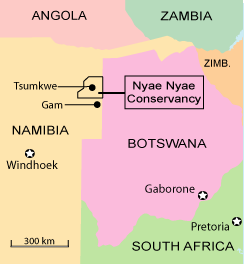A group of Herero families and their livestock have invaded the Nyae Nyae Conservancy, a major refuge for the Ju/’hoansi people that the government of Namibia created to protect them.
 Five Herero-speaking families from Gam, outside the reserve, cut the veterinary fence that surrounds it and moved onto the Ju/’hoansi lands with 132 cattle, 15 horses, 16 sheep, and 21 donkeys last week. According to press reports, the chief of police for the town of Tsumkwe, in the reserve, reported that the people had invaded because their animals were dying due to poisonous plants (Dichapetalum cymosum) where they came from.
Five Herero-speaking families from Gam, outside the reserve, cut the veterinary fence that surrounds it and moved onto the Ju/’hoansi lands with 132 cattle, 15 horses, 16 sheep, and 21 donkeys last week. According to press reports, the chief of police for the town of Tsumkwe, in the reserve, reported that the people had invaded because their animals were dying due to poisonous plants (Dichapetalum cymosum) where they came from.
The Herero families admit to having invaded on purpose, but they do not want to go back.
The difficulty for the police and government officials is that the Nyae Nyae reserve is not free of the foot and mouth livestock disease, so moving the Herero people back out of the area with their cattle would risk spreading it to healthy, disease free areas. Farmers outside the reserve do not want the invaders to come back since their animals might bring diseases along.
Officials thus face a dilemma, particularly since different agencies are not sure who should deal with the problem, or how. The Ministry of Environment is trying to cope, but it may instead be a problem for the Ministry of Lands to handle. A few days after the initial reports, on Friday last week, the Ministry of Agriculture, Water and Forestry ruled that the livestock that was moved into the reserve will not be allowed to return to Gam.
The Deputy Chief Veterinary Officer in the ministry, Cleopas Bamhare, said that the invaders’ cattle will be branded with special marks so they can be easily identified, and they will be destroyed if they are found outside the reserve. The owners of the cattle will be prosecuted, once they have been identified, for moving their animals without a permit and for vandalism to the fence. He said he is not aware of an immediate threat of disease, but caution is necessary.
Meanwhile, during the middle of the week, rumors were flying that more Herero and their livestock were crossing into the reserve. Local people fear that 350 additional head of cattle have crossed into the Ju/’hoansi property, and other sources say that more people, with their guns and dogs, are moving in. Dr. Bamhare confirmed on Friday that a second invasion of the conservancy property had occurred, but he provided no further information.
The government of Namibia created the 9,000 square kilometer reserve 20 years ago to preserve the Ju/’hoansi lands and give the people the ability to manage it effectively. The outgrowth of an earlier farmers’ cooperative, the reserve allows the Ju/’hoansi to implement projects after listening to the input of the communities involved. Up until now, the conservancy running the reserve has successfully persuaded invaders with their cattle to respect their rights and leave again. It was fenced to prevent the livestock disease found within from spreading into the rest of the country.
Zedekia Hengari, an Animal Health Technician at Gam, indicated that he has asked the police to patrol the Nyae Nyae fence round the clock to prevent further invasions. He is especially concerned about the health of the animals in his area. Local police are also talking with other stakeholders to try and resolve the matter.
The police at Tsumkwe said that a chief inside the reserve has allowed the invaders to settle on a farm temporarily until the matter can be resolved. Meanwhile, a legal assistance center was preparing papers in hopes of getting a court to intercede and order the invaders off the Ju/’hoansi lands.
